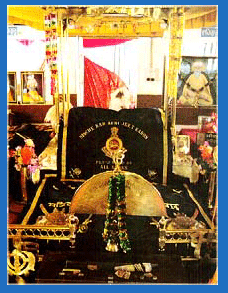Guru Nanak in Tibet Quotes
Gurdwara Pather Sahib
With kind thanks to: www.sikhphilosophy.com
There is a beautiful Gurudwara known as "Pather Sahib" constructed in the memory of Guru Nanak, about 25 miles away from Leh, on the Leh-Kargil road, 12000 ft above the sea level.
In the late 70s, during the construction of Leh-Nima road, a large stone was found in the middle. The bulldozer driver tried to push and throw away the stone but it did not move and in the process the blades broke and the work stopped. The driver had a dream that night not to move the stone. He narrated his dream to the army officer who did not give any importance to it. When all efforts to remove it failed it was decided to blow it with a dynamite the next day. That night the army officer also had a dream not to remove the stone but he again disregarded it. The next day being Sunday he noticed that early in the morning several Tibetans came and started showing reverence to the stone.
On enquiring further he was told that this was a "Wax Statue" of their revered Lama, Nanak and it contained the imnprints of his shoulders, head and backside.......he was told that during the period 1515-1518 AD when Guru Nanak was returning back to Punjab through Srinagar, after travelling to Sikkim, Nepal and Tibet, he rested at this place. A woman came to him for help. It was her son that was to be sacrificed to a demon who lived on the hill. Guru Nanak consoled her and asked her not to send her son to the demon. The demon was infuriated and threw a large rock at the Guru which hit the back of the meditating Guru and stopped there. The Guru's body is believed to be imprinted on the rock. The demon felt ashamed and prostrated at the feet of Guru Nanak.
GURU NANAK IN TIBET - A Buddhist Viewpoint?
Tarungpa Tulku (As published in the Indian Express, March 6th, 1966)
It gave me great pleasure when I was asked to write this article as I have wanted for a long time to say something about my impressions of the Religion of the Sikhs in India, and my connections with it. After my escape from Tibet, I lived as a refugee in India for several years, alongside so many of my countrymen. There I had the great good fortune to be looked after by a Sikh family, by Baba Bedi, his English wife, and their three children. While I was with them, I was able to visit many of the Sikh holy places and I was given hospitality there.
My interest in Sikhism is not only a personal one, however. In Tibet, Guru Nanak is revered as an emanation of Guru Padmasambhava. Many of our pilgrims visited Amritsar and other holy places which they looked upon as equal in importance to Buddha-Gaya. They always said that the Sikhs treated them with great respect and were very hospitable: " as our expression goes, they bowed down to their feet." It seems that the Sikhs really practice the doctrine of their religion; perhaps they are the only ones who give such wonderful dana to travellers.
Most Tibetans know that Guru Nanak visited Tibet, and the mystical ideas of our two religions are very similar. I have noticed that the Sikhs never worship images in their shrines, but that there is in the centre the book, the Guru Granth Sahib. In our tradition, one of the last things that the Buddha said was that in the dark age after his death he would return in the form of books. "At that time," he said, "look up to me and respect me." Just as we do not believe in mystifying rituals, so in the Sikh ceremonies, it seems that the people simply read and contemplate the words of their text, so that no misunderstandings arise.
I was interested in the Sikh symbolism of the three daggers: in Buddhism, a knife often appears as the cutting off of the roots of the three poison, greed, hatred and illusion. I was also very interested in the Sikh practice never to cut one's hair, as this is also the practice among Tibetan hermits and contemplatives. The most famous of these was Milarepa, who said that there were three things that should be left in their natural state; one should not cut one's hair, dye one's clothes, nor change one's mind. It is true that most Tibetan monks wear yellow, and shave their heads; these are practices that come from India, and symbolise humility and detachment from worldly things. Outside the more organized monastic tradition, however, the emphasis is that the natural goodness and power of growth within should be allowed to develop freely without interference from outside.
Both Guru Nanak and the Buddha said to their followers that the real nature of the universe should not be limited by the idea of personal god and gods. Those who made offerings at their shrines should remember that the whole universe was the power offering offered before and to itself. Although Guru Nanak did not think of himself as a founder of a new school of thought, it seems that there is very much in common between our philosophies.
When I return to India, I hope to increase understanding of the Sikh religion among Tibetan people, and it is my wish one day to translate the Guru Granth Sahib into Tibetan. Now I am living in England, and I can see that much good might be accomplished by Sikhism in England, and Europe and America, and I wish success to everyone whose concern this is.
Read the full Discussion at: www.sikhnet.com

